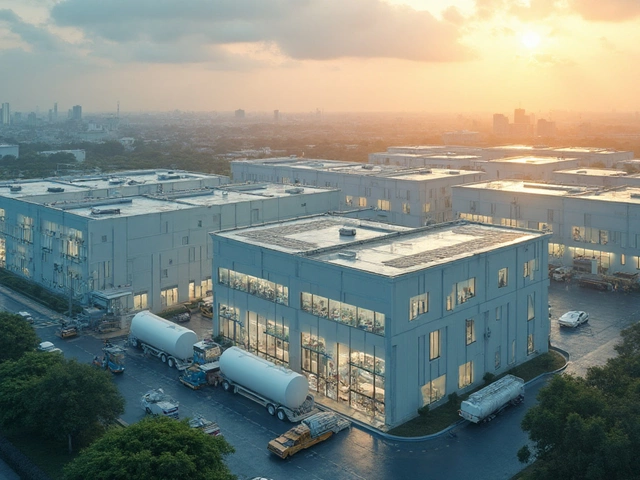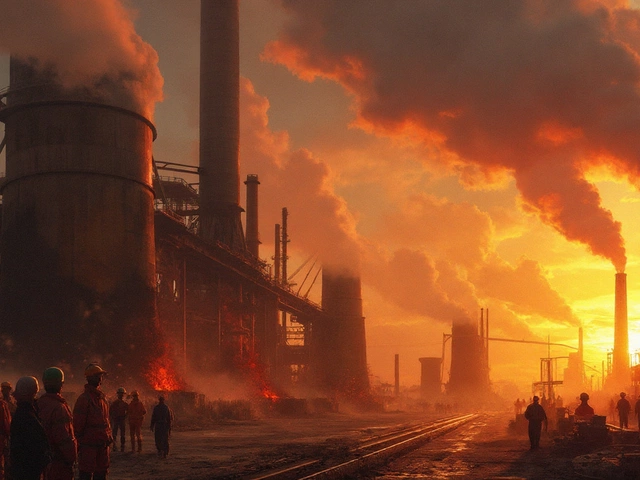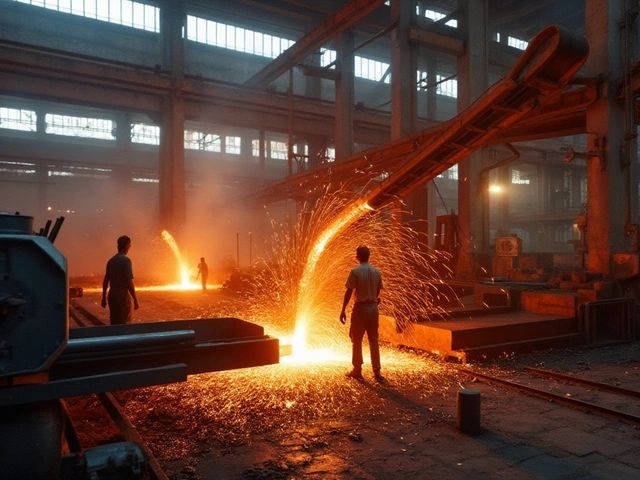Manufacturing industry benefits show up fast where people live: steady jobs, better wages, strong supply chains, and skills that stick. Manufacturing is a sector that transforms raw materials into finished goods and drives local employment, income growth, and knowledge spillovers. In Australia, it still employs roughly 6% of workers and contributes about 6% of GDP (ABS Labour Account 2024). And here’s the kicker: for every 100 manufacturing jobs, another 160-200 jobs typically show up around town through suppliers, logistics, and local services (OECD inter-industry multipliers). That’s why a single factory can feel like an economic anchor.
TL;DR
- Manufacturing creates stable, well-paid jobs and apprenticeships locals can access without moving away.
- Every plant sparks a web of small suppliers, boosting local shops, trades, freight, and services.
- It builds skills-through VET, apprenticeships, and on-the-job training-that raise lifetime earnings.
- Rates, payroll tax, and infrastructure investment expand public services and community amenities.
- With modern tech and circular practices, you can grow industry and improve local air, water, and waste outcomes.
How manufacturing puts money in local pockets
Want a quick read on pay packets? Manufacturing roles often pay a wage premium for comparable skills. The OECD and ILO repeatedly find a 5-15% premium in many countries for mid-skill roles versus similar service jobs. In Australia, ABS earnings data also show trade-qualified roles in production, maintenance, and quality control earning above local retail or hospitality averages. Steady rosters and overtime add predictability-crucial for families juggling rent, childcare, and transport.
Economic multiplier is a measure that shows how one job or dollar in a sector supports additional jobs and spending across the local economy. Manufacturing’s total employment multiplier typically sits between 1.6 and 2.5 depending on subsector and region (OECD IO tables, ABS multipliers). Translate that: 300 direct jobs can sustain 500-750 total jobs when you count local suppliers, fuel stations, food outlets, tool shops, and even sports clubs that sell more pies after payday.
From shop floor to career ladder: skills that stick
Factories don’t just hire; they train. That’s the long-term value for locals.
Workforce development is a coordinated approach to training, upskilling, and job matching that moves people into better-paid roles. When a plant partners with a TAFE or community college, entry-level hires can climb into higher-value roles in quality assurance, machine programming, or maintenance.
Vocational Education and Training (VET) is a practical education system providing industry-recognized certificates and diplomas for trades and technical roles. In Australia, Certificate III/IV pathways feed straight into process manufacturing, mechatronics, and fabrication. Higher up, diplomas and degrees unlock planning, supply chain, and production engineering.
Apprenticeship is an earn-while-you-learn model combining paid work with structured training, usually 3-4 years, leading to a trade qualification. Apprenticeships tackle youth unemployment, reduce drop-out rates, and keep young people rooted in their community. The pay rises each year, the skills are portable, and completion rates are strongest when employers and training providers coordinate rosters and mentoring.
The supply chain effect: why SMEs win when a plant opens
Big plants need small firms. That’s where a lot of local opportunity sits.
Supply chain is the network of suppliers, logistics, and services that deliver materials and parts to a manufacturer and move products to customers. A typical plant buys inputs from dozens of local and regional suppliers: metals, packaging, chemicals, spare parts, tooling, calibration, and safety gear.
Small and medium-sized enterprises (SMEs) are locally owned firms-often with 5-200 staff-that provide parts, maintenance, and services to larger manufacturers. SMEs gain steady purchase orders and the confidence to hire apprentices, buy new machines, and pursue ISO certifications. The result? More money cycles within the community instead of leaking out.
Industrial cluster is a geographic concentration of related manufacturers, suppliers, and training institutions that share talent, infrastructure, and knowledge. Clusters reduce costs (shared freight and warehousing), speed up problem-solving (you can call a nearby toolmaker), and make the area more attractive to new investment. Think of a food precinct with processors, cold storage, packaging converters, and a nearby TAFE running HACCP training.
Public revenue and local services
Manufacturers pay rates, payroll tax, and user charges. They also buy lots of electricity, gas, water, and transport, which improves utilization of local infrastructure. Councils can then justify better roads, lighting, and industrial estate upgrades that also help other businesses. Property values in well-planned industrial zones tend to rise when access, safety, and amenities improve. That’s a quieter benefit, but very real.
Innovation, exports, and outside money flowing in
When a region makes things the world wants, outside money comes in and stays local. That’s where innovation and trade matter.
Research and development (R&D) is systematic work to create new products or processes or significantly improve existing ones. Plants that spend even 1-3% of revenue on R&D often introduce higher-margin products, keep skilled staff engaged, and attract partnerships with universities.
Advanced manufacturing is production that uses digital tools, automation, robotics, and materials science to deliver high precision and customization. This is where you see CNC machining, additive manufacturing, AI-driven quality control, and low-defect pharmaceutical lines. It boosts productivity, which supports higher wages without pricing the plant out of the market.
Manufactured exports are goods shipped overseas, bringing external revenue into the local economy. Exporting plants buffer a town against local demand swings and can grow headcount even in local slowdowns. Think medical devices that sell into Asia-Pacific hospitals or food brands that ride demand in the Middle East.
Foreign direct investment (FDI) is capital from overseas companies invested to build or expand local production. Good FDI brings new technology, supplier opportunities, and global market access. Local content and training agreements help lock in benefits for residents.
Environment and community: doing more with less
This isn’t the smokestack era. Modern plants can reduce emissions, water use, and waste while creating better jobs.
Environmental management system (EMS) is a structured framework to manage environmental impacts, often aligned to ISO 14001. Facilities with an EMS track energy intensity (kWh per unit), water consumption, and waste-to-landfill, and then set annual reduction targets tied to investment.
Circular economy is a production model that designs out waste, keeps materials in use, and regenerates natural systems. On the ground, that means regrinding plastic scrap, selling metal offcuts to recyclers, heat recovery on ovens, and repair/refurbishment services that add jobs while cutting waste.
Community benefits show up as cleaner air (captured dust and VOC controls), quieter nights (acoustic treatments), and safer streets (shift traffic planning). When companies publish environmental dashboards and host open days, trust rises and planning gets a lot easier.
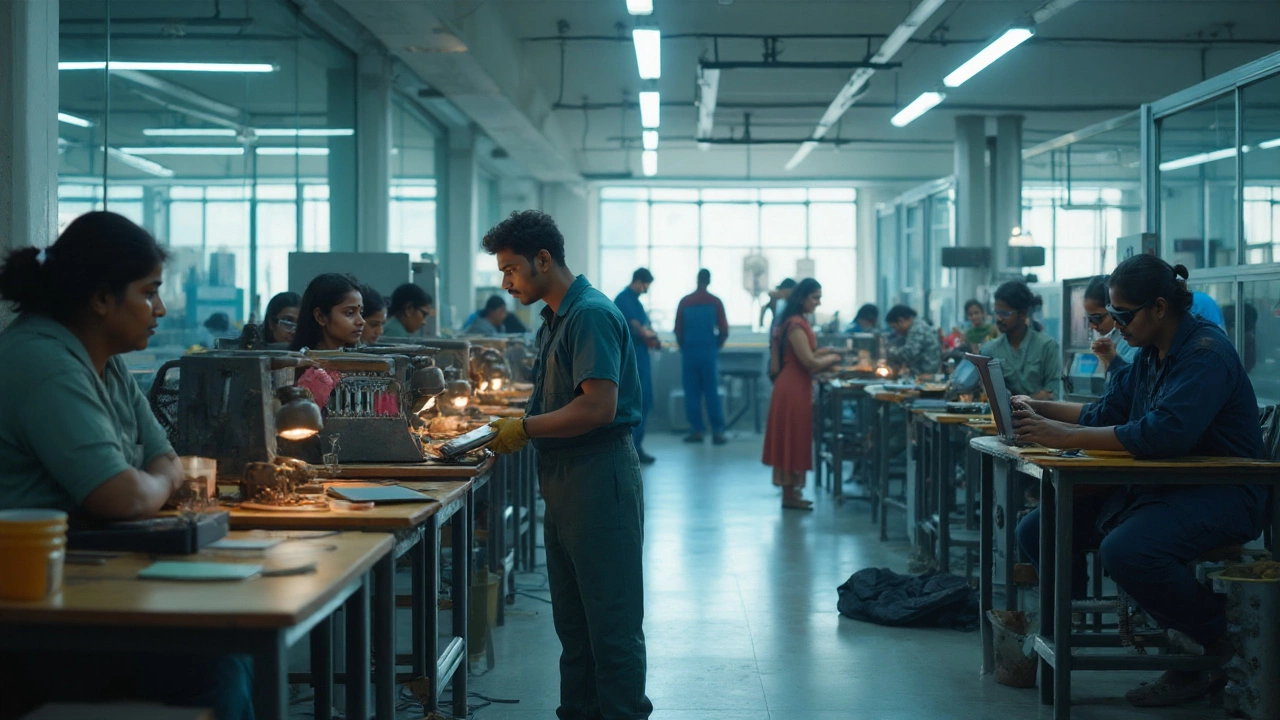
What different types of manufacturing bring to a town
Not all factories are the same. Some hire more per dollar of sales; others pay more per role. Here’s an at-a-glance view to help councils, chambers, and residents make sense of trade-offs. Values are indicative based on ABS multipliers, OECD IO tables, and industry associations.
| Subsector | Job intensity | Average wage index (local = 100) | Total employment multiplier | Typical qualification pathway | Export ratio | Resource intensity highlights |
|---|---|---|---|---|---|---|
| Food processing | High | 100-115 | ~1.8-2.0 | VET Cert III in Food Processing; HACCP | 25-40% | Higher water use; heat recovery often viable |
| Textiles & apparel | High | 90-105 | ~2.0-2.2 | VET Cert III in Textile Production; pattern tech | 10-20% | Water/chemicals management important |
| Electronics | Medium | 120-140 | ~2.2-2.4 | Cert IV Electronics or Bachelor EE/Mechatronics | 40-60% | Lower water, cleanroom energy can be high |
| Pharmaceuticals | Medium | 140-160 | ~2.0-2.2 | Bachelor Science/Chem Eng; GMP training | 60-80% | Strict quality/waste controls; high R&D |
Real-world examples you can picture
- A mid-sized food plant adds a second shift. Local bakeries, cleaners, forklift trainers, and freight depots add staff. The council fast-tracks a turning lane near the estate, reducing noise and idling trucks.
- An electronics firm brings in a pick-and-place line. It hires two apprentices, a maintenance tech, and a quality engineer. A nearby TAFE launches a short course in surface-mount rework to help smaller repair shops win service contracts.
- A packaging converter signs a deal with a national brand. It invests in a print line, negotiates a recycled-content feedstock, and partners with a recycler. Several micro-businesses pop up to do pallet repair, machine guarding, and safety training.
How to capture more local benefit (without guessing)
Here’s a simple playbook councils, employers, and residents can use.
- Local hiring pact: commit a portion of entry-level roles to residents, plus guaranteed interviews for certified graduates.
- Supplier readiness: run audit-lite programs that help SMEs meet basic quality, safety, and traceability so they can bid for contracts.
- Skills ladder: map 5-6 role progressions (e.g., operator → setter → technician) with clear pay bands and training modules.
- Transparent dashboards: share safety, environment, and community investment metrics; it builds trust and speeds planning approvals.
- Shared assets: co-fund a training cell, metrology lab, or cold-store hub in the industrial estate that multiple firms can book.
- Shift-friendly services: align bus timetables, childcare hours, and lighting around shift changes to widen the talent pool.
Trade-offs and how to manage them
Yes, there are trade-offs. Good planning turns them into solvable problems.
- Noise and traffic: enforce delivery windows, build turning lanes, and add acoustic fencing. Simple changes can cut complaints sharply.
- Air and water: use modern dust control, solvent capture, and closed-loop water systems. Track kWh/unit and kL/unit, not just totals.
- Automation fears: robots shift the mix of jobs; they rarely erase demand. Offer upskilling into maintenance, programming, and quality.
- Land use pressure: protect industrial land near freight links; once it becomes housing, it rarely comes back.
Related concepts and connected topics
Manufacturing sits inside a bigger economic story that also covers transport, energy, education, and trade. If you want to go deeper, explore:
- Industrial land-use planning and freight corridors
- Energy affordability and grid reliability for producers
- Export development and trade compliance
- Industry 4.0 adoption roadmaps for SMEs
- Local content policies and public procurement
Each of these connects back to jobs, small business growth, and household income stability.
Quick checklist for councils, employers, and residents
- Do we have a current map of local suppliers and their capabilities?
- Which three VET courses align with our biggest hiring needs?
- What’s our current employment multiplier, and how can we lift local capture (more local suppliers, better transport)?
- Are we tracking energy, water, and waste per unit so savings show up in bids and approvals?
- Where are the choke points (bus at shift change, truck access, late-night noise) and what’s the next fix?
Next steps
- Councils: set up a quarterly industry roundtable with HR leads, procurement teams, and the local TAFE. Publish a simple dashboard on jobs, apprenticeships, and supplier spend.
- Manufacturers: build a two-page skills ladder and share it with schools and job agencies. Offer plant tours; they convert interest into applicants.
- SMEs: pick one certification that unlocks bigger customers (ISO 9001, HACCP, or a customer’s supplier standard). Use a short grant or cluster fund to offset the audit cost.
- Residents: if you’re job hunting, look for roles titled operator, assembler, packer, technician, or quality assistant. Ask about training, not just pay.
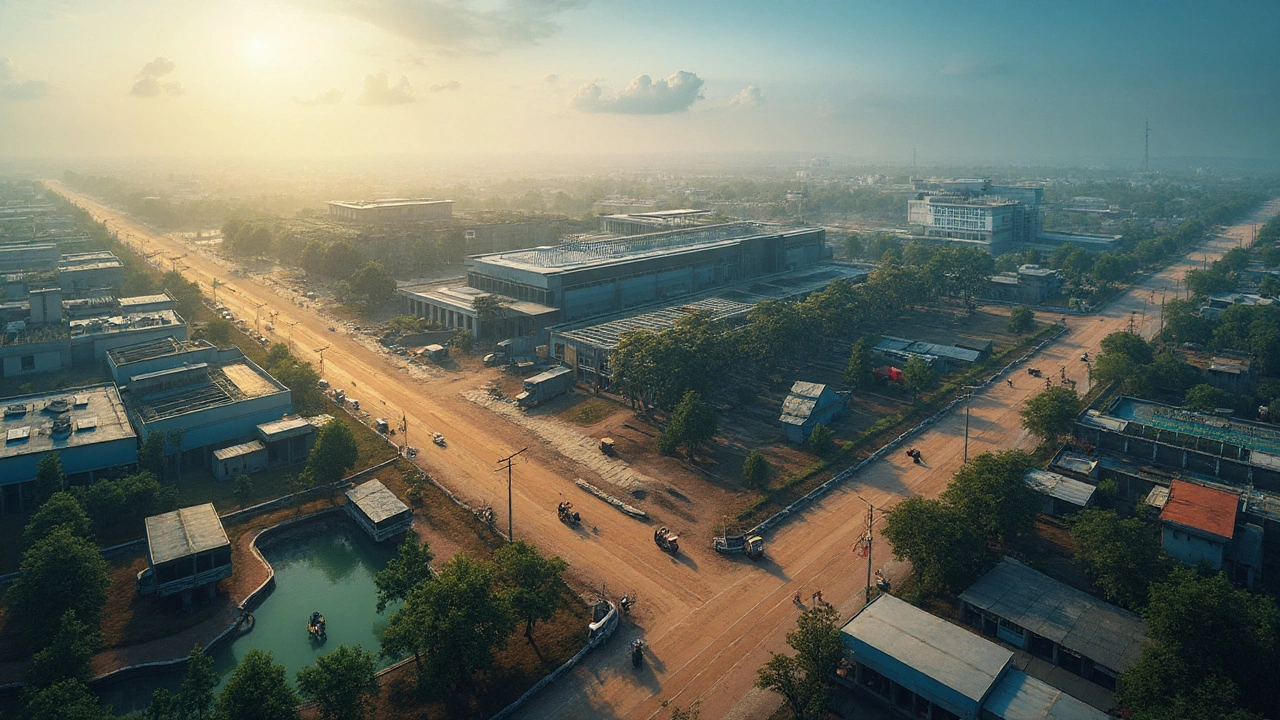
Frequently Asked Questions
What kinds of jobs do manufacturing industries create for local people?
You’ll see entry-level operators, packers, and warehouse roles; mid-skill machine setters, maintenance technicians, and quality inspectors; and higher-skill planners, engineers, and supervisors. Many roles are accessible with VET certificates, and employers often pay for on-the-job upskilling. Apprenticeships in fabrication, electrical, and fitting/turning are steady pathways for school leavers.
How big is the local multiplier from a new factory?
A typical total employment multiplier ranges from about 1.6 to 2.5 depending on the subsector and region. That means 100 direct plant jobs support 60-150 extra jobs in suppliers, logistics, and local services. Numbers come from input-output analysis (OECD, ABS). The more local the supply base, the higher the capture of those benefits inside the community.
Do small businesses really benefit, or do big firms take it all?
SMEs gain steady orders for parts, maintenance, packaging, cleaning, calibration, safety gear, and contractor services. A single mid-sized plant can support dozens of local suppliers. When councils and primes run supplier-readiness programs (quality, safety, traceability), even micro-businesses can bid and grow.
Does automation reduce the local benefit?
Automation changes the job mix. It usually reduces repetitive manual tasks but increases demand for maintenance, programming, quality, and process improvement. Plants that automate tend to stay competitive and keep operating locally, which protects the broader supply chain and tax base. Pair automation with training so locals move into higher-value roles.
Can manufacturing be both good for jobs and the environment?
Yes. Modern plants use environmental management systems, energy-efficient motors, heat recovery, and water recycling. Circular practices-regrind, remanufacture, repair-create extra local jobs while cutting waste and costs. Publishing kWh/unit, kL/unit, and waste per unit builds trust and helps win approvals faster.
Is manufacturing still relevant in high-wage regions?
Absolutely. Advanced manufacturing-medical devices, electronics, pharmaceuticals, precision engineering-competes on quality, reliability, and speed, not just labor cost. Close-to-market production also shrinks lead times and inventory risk, which many customers value more than the last dollar of unit cost.
Which manufacturing sectors bring the most jobs versus the highest pay?
Food and textiles are typically more job-intensive per dollar of output, creating broader entry-level opportunities. Electronics and pharmaceuticals tend to pay more per role and drive stronger R&D but hire fewer people per unit of revenue. The best mix for a town balances both: high job intensity and high-value, high-wage anchors.
What policies help locals capture more benefits?
Targeted training (VET and apprenticeships aligned to real vacancies), supplier development programs, industrial land protection near freight links, and transparent community reporting. Avoid incentives that only shift jobs across town; aim for investments that lift productivity and local supply capacity.
How can residents plug in quickly if a new plant opens?
Watch for operator, assembler, warehouse, and quality assistant roles. Ask about paid training, shift options, and progression to setter or technician. If you’re young or changing careers, explore Cert III/IV courses in process manufacturing, electronics, fabrication, or supply chain. Plant tours and pre-employment programs are the fastest on-ramps.
OECD input-output tables are official datasets that measure how industries buy from and sell to each other, used to calculate multipliers. and ABS Labour Account is Australia’s consolidated dataset on jobs, hours, and earnings by industry. are good starting points if you want to validate the figures raised here.




